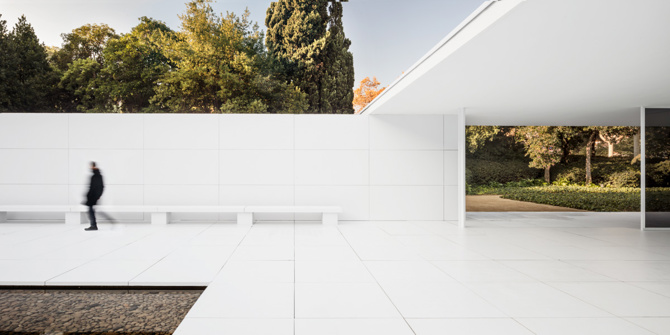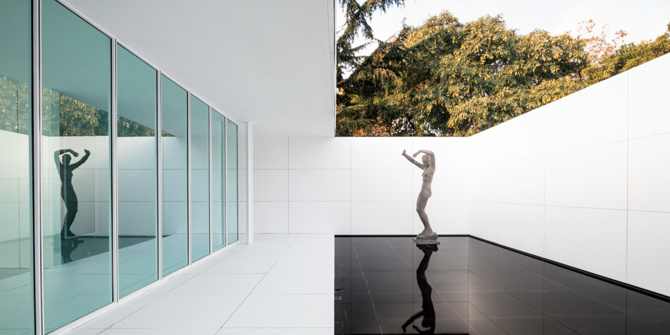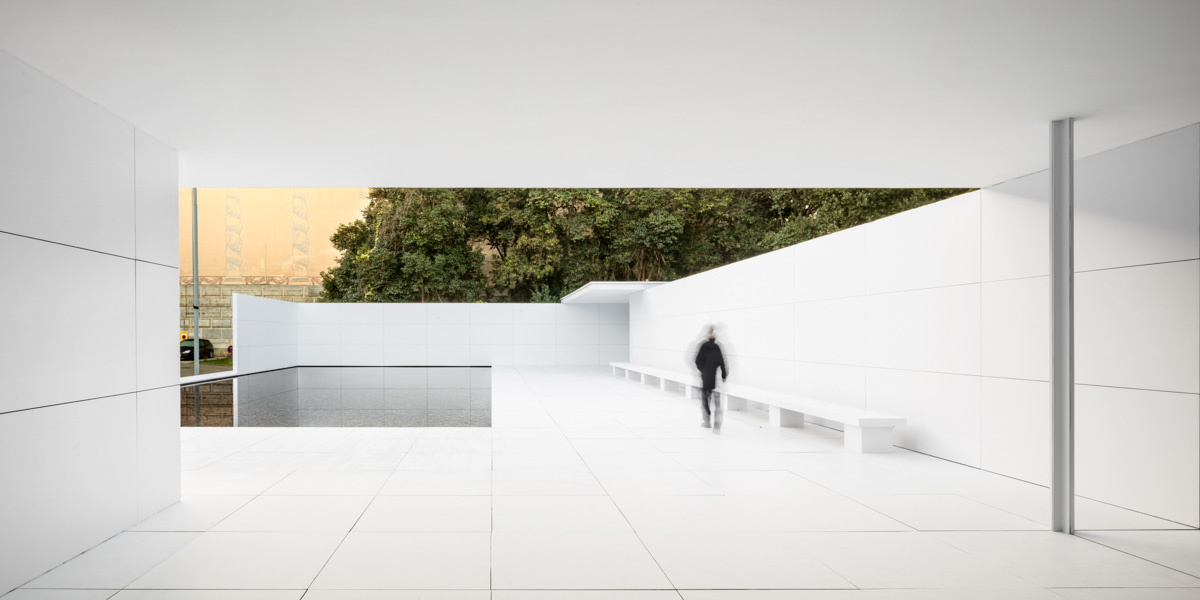Loading...
Dressing up the Mies van der Rohe Pavilion to strip it of its materiality. With this simple action, the pavilion becomes a representation of itself and opens the door to multiple interpretations of aspects such as the value of the original, the role of the white surface as an image of modernity or the importance of materiality in the perception of space.
The Barcelona Pavilion we are working on is a reconstruction; a replica so faithful to the original that it is often difficult to remember its true nature. A building that was to be temporary was immortalised in the first instance by the written account of the modern movement, and later by its own reconstruction.


Turning the pavilion into an image of itself, with all its surfaces limited to a single material, highlights the representative role of the building; both that of the original, as a national symbol, and that of the replica, as a representation of the former. The pavilion becomes, for a time, a 1:1 scale model of the replica of the longest-lived temporary pavilion in modern architecture. Subtracting part of the materiality of the pavilion also opens up other interpretations linked to the historiography of 20th century architecture.

The Barcelona Pavilion was enthroned as an icon of modernity at the Modern Architecture exhibition at the Moma in New York in 1932. In the exhibition catalogue, several buildings by architects such as Mies van der Rohe himself, Le Corbusier, Neutra, Wright, Oud and Gropius, among others, are presented through a selection of photographs and critical writings in which Philip Johnson and Henry Russell Hitchcock point out the homogenising criteria for bringing all the works together under a single focus. Among these criteria, the white surface, as an emblem of a new architecture, appears as one of the most insistent.
Providing the Barcelona Pavilion with this homogenising whiteness means endowing it with one of the defining characteristics of modern historiography - but not of modernity - although at the same time it means stripping the pavilion of its materiality, of its unique character; the very character that made it an icon of the modern movement itself.


The installation turns this paradox into an experience. It allows visitors to consider these and other reflections through their own experience in a pavilion that, for a few days, loses its material trace in order to assume its full representational and relational potential. It allows us to reflect on such transversal aspects as the value of imperfection, in an altered pavilion that appears neat and immaculate on the first day, but which shows all the traces of desire after days of visits.

It reinforces the interpretation of the pavilion as a temple of the German soul, now white, but still devoid of its eight columns on the entrance façade. We can compare it with the image of that model made of white fabrics that Mies supposedly made for the Kröller-Müller family.

And among other reflections, he shows us the power of the joints, now perfectly visible as the textures and reflections that concealed them disappear, reminding us of one of Mies's characteristic perspectives or collages, which we can now walk through. An installation that, in short, functions as a trigger for reflection.
General information
Mies missing materiality
YEAR
Status
Efímera
Option to visit
Address
Ave. Francesc Ferrer i Guàrdia, 7
08038 Barcelona - Barcelona
Latitude: 41.370636481
Longitude: 2.1501626992
Classification
Built area
Information provided by
Anna & Eugeni Bach
Website links
Location
https://serviciosdevcarq.gnoss.com/https://serviciosdevcarq.gnoss.com//imagenes/Documentos/imgsem/ab/ab46/ab46c2e4-dc31-4d5f-b81e-626a3820904a/02209e64-3c94-42cb-9397-75ea9f5db0f5.jpg, 0000033685/_AG_3887+88web.jpg
https://serviciosdevcarq.gnoss.com/https://serviciosdevcarq.gnoss.com//imagenes/Documentos/imgsem/ab/ab46/ab46c2e4-dc31-4d5f-b81e-626a3820904a/8ae807ad-05c3-4c9c-8163-283eb936f359.jpg, 0000033685/_AG_3926+27web.jpg
https://serviciosdevcarq.gnoss.com/https://serviciosdevcarq.gnoss.com//imagenes/Documentos/imgsem/ab/ab46/ab46c2e4-dc31-4d5f-b81e-626a3820904a/4468250e-f956-4d6a-9941-7fa62f3fb2ef.jpg, 0000033685/_AG_3880+81web.jpg
https://serviciosdevcarq.gnoss.com/https://serviciosdevcarq.gnoss.com//imagenes/Documentos/imgsem/ab/ab46/ab46c2e4-dc31-4d5f-b81e-626a3820904a/9daf0cc4-3bc5-452d-9513-483dac84aeac.jpg, 0000033685/_AG_4023+24web.jpg
https://serviciosdevcarq.gnoss.com/https://serviciosdevcarq.gnoss.com//imagenes/Documentos/imgsem/ab/ab46/ab46c2e4-dc31-4d5f-b81e-626a3820904a/411992b4-05bd-43b1-a144-a5b0b65f45a1.jpg, 0000033685/_AG_4126+27web.jpg
https://serviciosdevcarq.gnoss.com/https://serviciosdevcarq.gnoss.com//imagenes/Documentos/imgsem/ab/ab46/ab46c2e4-dc31-4d5f-b81e-626a3820904a/e7a90bfd-f709-4f7a-9d5f-f33da9313962.jpg, 0000033685/_AG_3947+48web.jpg
https://serviciosdevcarq.gnoss.com/https://serviciosdevcarq.gnoss.com//imagenes/Documentos/imgsem/ab/ab46/ab46c2e4-dc31-4d5f-b81e-626a3820904a/8bbf4d59-3386-468f-ba43-c275d0fff3aa.jpg, 0000033685/metalocus_mies_van_der_rohe_blanco_10.jpg
https://serviciosdevcarq.gnoss.com/https://serviciosdevcarq.gnoss.com//imagenes/Documentos/imgsem/ab/ab46/ab46c2e4-dc31-4d5f-b81e-626a3820904a/74818629-202a-43de-ab0b-a3ef02946533.jpg, 0000033685/_AG_9667_WEB.jpg
https://serviciosdevcarq.gnoss.com//imagenes/Documentos/imgsem/ab/ab46/ab46c2e4-dc31-4d5f-b81e-626a3820904a/22b3b0cf-13ee-4729-b1d0-caf5b1717979.jpg, 0000033685/MiesMissingMateriality_AEB_low.jpg








